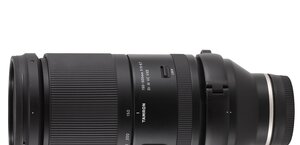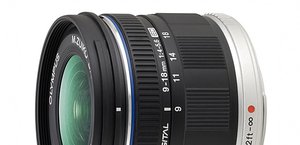Nikon Nikkor AF-S 70-200 mm f/4.0G ED VR
3. Build quality and image stabilization
In the photo below the Nikkor AF-S 70–200 mm f/4.0G ED VR is positioned next to the Nikkor AF 50 mm f/1.8D and the Canon EF 70–300 mm f/4.0–5.6 IS USM.
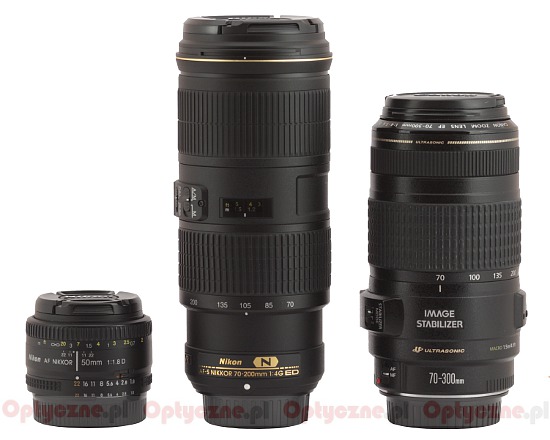 |
Please Support UsIf you enjoy our reviews and articles, and you want us to continue our work please, support our website by donating through PayPal. The funds are going to be used for paying our editorial team, renting servers, and equipping our testing studio; only that way we will be able to continue providing you interesting content for free. |
- - - - - - - - - - - - - - - - - - - - - - - - - - - - - - - - - - - - - - - - - - - - - - - -
The tested lens starts with a metal mount which surrounds contacts and a rear opening, 34 mm in diameter. In that opening there is a rear element, hidden 2.5 cm deep inside and immobile. The area around it is matted and darkened in the right way.
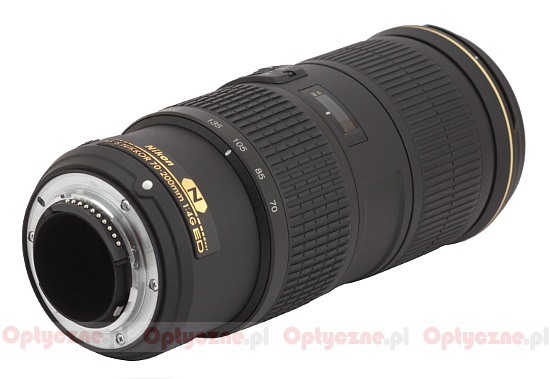 |
The proper body of the lens starts with a white dot which makes the alignment with a camera easier; behind that there is a plate with the name and the parameters of the lens and a big “N” mark meaning that NanoCrystal coatings have been used. On the left side of the plate, so on the other side of the lens, you can find its serial number.
The next part of the lens is the place where You can attach a tripod adapter constitutes ; unfortunately the adapter must be bought separately. Immediately afterwards there is a zoom ring, 39 mm wide. Most of it is occupied by rubber ribbing and below there are focal lengths markers at 70, 85, 105,135 and 200 mm. The ring moves smoothly and is well-damped.
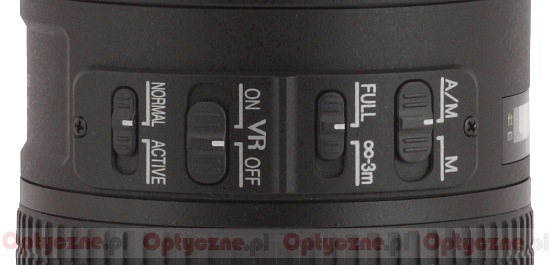 |
Further on, there is a distance scale behind a window, expressed in feet and meters. On the left side of that scale you can find a series of switches: the first one allows you to choose the focusing mechanism mode (A/M-M), the second one can limit its range with two options available (FULL and from 3 meters to infinity). Two following switches concern stabilization: the first one turns it on and off (VR ON/OFF), the second allows you to choose its mode (NORMAL, ACTIVE). On the opposite side of the lens to the distance scale there are inscriptions promoting the technologies used in the lens and also the info that the lens was produced in Thailand.
The next part of the lens is a manual focus ring. It is 43 mm wide and most of it is covered by rubber ribs. The ring works smoothly and is damped-down nicely. What’s important it doesn’t have those slacks which happen from time to time to even more expensive Nikkors. Running through the whole distance scale takes a turn through an angle of about 150 degrees. Behind the ring there is an immobile element of the casing with a hood mount.
The front element doesn’t move as well and it is 56 mm in diameter. The element is just slightly hidden inside the casing and surrounded by a non-rotating filter thread, 67 mm in diameter.
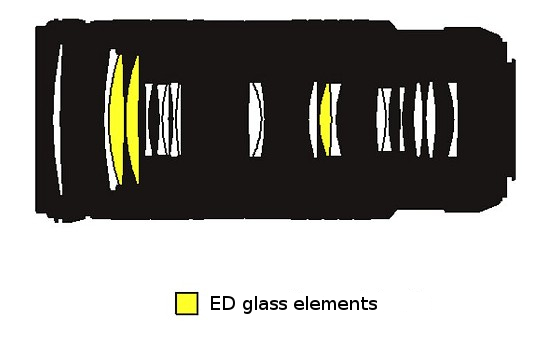 |
The optical construction of the tested lens consists of 20 elements positioned in 14 groups, with three ED low dispersion glass elements, one HRI high refraction index element and one with a nano crystal coating. Inside you can also find a circular aperture with nine blades which can be closed down to the value of f/32.
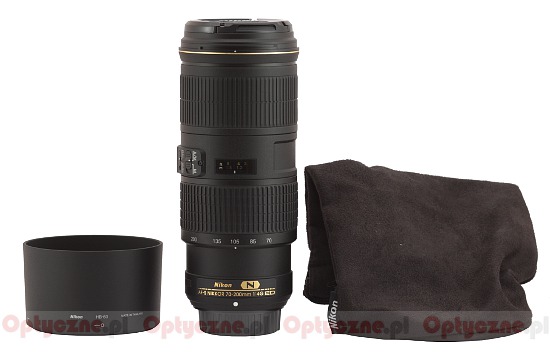 |
The buyers gets both caps, a hood and a soft pouch in the accessory kit. Optionally you can also purchase a tripod adapter marked as RT-1.
Optical stabilization
Nikon is the first lens manufacturer which started to boast of optical stabilization as efficient as 5 EV. The Nikkor 70–200 mm f/4.0 VR, tested here, is supposed to be an instrument with such a stabilization exactly. As usual we decided to check that claim. In order to do that we set the focal length at 200 mm and for each exposure time ranging from 1/200 to 1/3 of a second we took several photos first with the stabilization switched off and then switched on. For every exposure time we calculated the percentage of fuzzy photos and presented it as the time exposure function, expressed in EV, where the 0 EV point is the equivalent of 1/160 of a second.
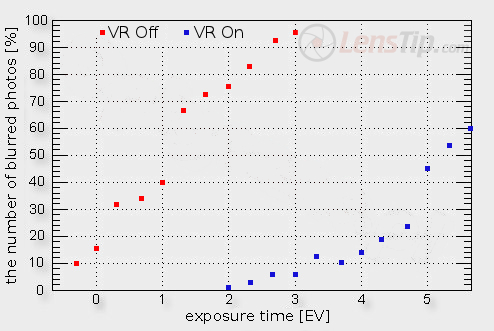
As you can notice the maximum distance between both curves amounts to about 4.3 EV – so it is short by a bit of those declared 5 EV. It should be emphasized, though, that the reached result is still sensational. It is impressive that you can count on the fact that every second photo you take will be sharp even using 1/5-1/3 of a second exposure times at the maximum relative aperture.
In order not to make this picture too rosy we must mention one thing, though. During one series of photos the stabilization got stuck completely. First nine shots were completely blurry as if the mechanism didn’t work at all, then something changed and all the rest of photos managed to stay sharp. Such a situation happened just once during the whole test so we don’t consider it to be a serious flaw. However, if it started to repeat itself, we would have a lot of reservations.




